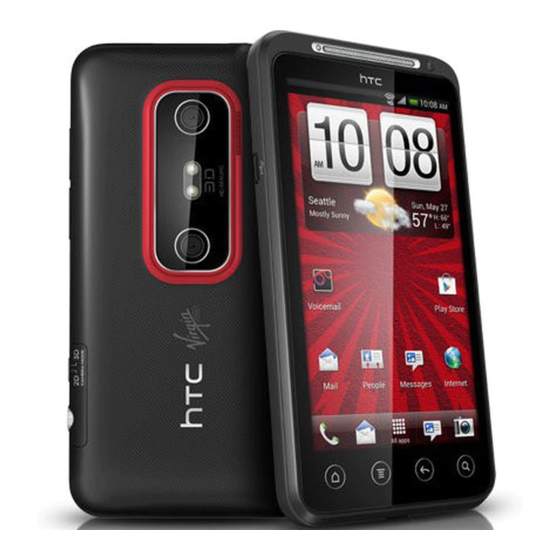HTC HTC Evo View 4G Podręcznik podstawowy - Strona 37
Przeglądaj online lub pobierz pdf Podręcznik podstawowy dla Tablet HTC HTC Evo View 4G. HTC HTC Evo View 4G 42 stron. Sprint
Również dla HTC HTC Evo View 4G: Specyfikacje (1 strony), Rozpocznij (41 strony), Podręcznik dla początkujących (15 strony)

This phone has been tested and rated for use with hearing aids for some of the wireless
technologies that it uses. However, there may be some newer wireless technologies used in
this phone that have not been tested yet for use with hearing aids. It is important to try the
different features of this phone thoroughly and in different locations, using your hearing
aid or cochlear implant, to determine if you hear any interfering noise. Consult your service
provider or the manufacturer of this phone for information on hearing aid compatibility.
If you have questions about return or exchange policies, consult your service provider or
phone retailer.
For information about hearing aids and digital wireless phones
FCC Hearing Aid Compatibility and Volume Control:
http://www.fcc.gov/cgb/dro/hearing.html
Gallaudet University, RERC:
https://fjallfoss.fcc.gov/oetcf/eas/reports/GenericSearch.cfm
SAR Information
0.885 W/kg @ 1g (HEAD)
1.11 W/kg @ 1g (BODY)
THIS MODEL DEVICE MEETS THE GOVERNMENT'S REQUIREMENTS FOR EXPOSURE
TO RADIO WAVES. For body worn operation, this phone has been tested and meets the
FCC RF exposure guidelines when used with the HTC Corporation. Accessories supplied or
designated for this product. Use of other accessories may not ensure compliance with the
FCC RF exposure guidelines.
Your wireless mobile phone is a radio transmitter and receiver. It is designed and
manufactured not to exceed the emission limits for exposure to radio frequency (RF)
energy set by the Federal Communications Commission of the U.S. Government. These
limits are part of comprehensive guidelines and establish permitted levels of RF energy for
the general population. The guidelines are based on the safety standards previously set by
both U.S. and international standards bodies:
American National Standards Institute (ANSI) IEEE. C95.1-1992.
National Council on Radiation Protection and Measurement (NCRP). Report 86. 1986.
International Commission on Non-Ionizing Radiation Protection (ICNIRP) 1996.
Ministry of Health (Canada), Safety Code 6. The standards include a substantial
safety margin designed to assure the safety of all persons, regardless of age and
health.
Basics Guide 37
